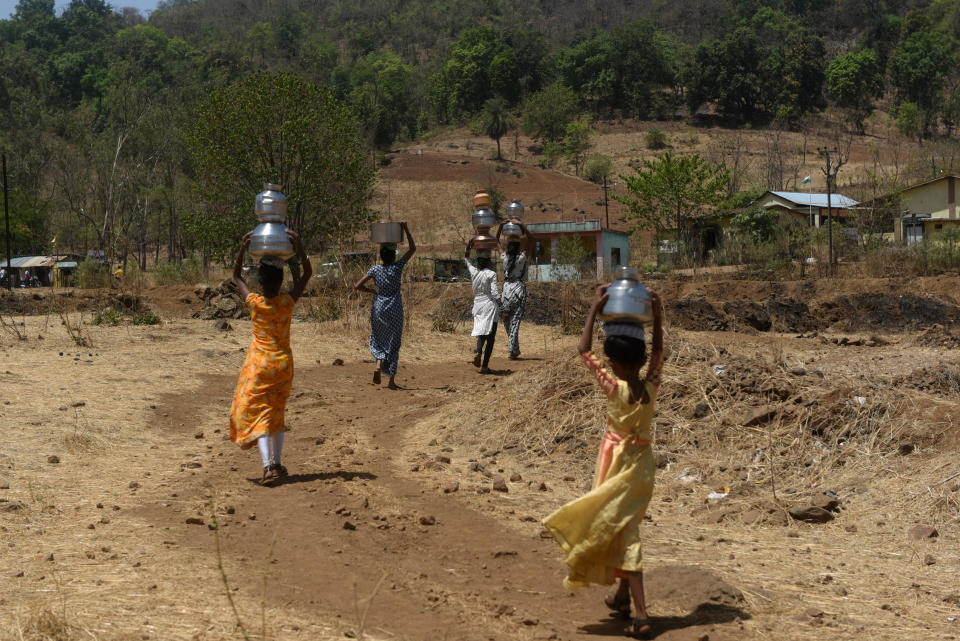New Delhi — It’s still spring, but hundreds of millions of people in South and Southeast Asia are already facing scorching heat. The summer heat came early, breaking records and even claiming lives. With the onset of summer, the weather is expected to get much worse in May and June.
At the beginning of May, nearly three dozen deaths in the wider region were blamed on severe heat waves. Schools were forced to close weeks before the summer holidays and large amounts of new crops withered on arid farmland.
Where the most dangerous heat is expected in the US this summer
Scientists are warning of far-reaching impacts in some of the world’s most densely populated areas and calling on governments to take immediate action to prepare for the effects of climate change and do everything possible to reduce human-caused global warming.
What’s happening and where?
Maximum temperatures above 110 degrees Fahrenheit were recorded in various parts of India last month. On April 21, people in the eastern city of Bhagdora were overwhelmed as the mercury reached 114.8 degrees.
The India Meteorological Department (IMD) on Tuesday issued a “red alert” warning for the eastern and southern states of Andhra Pradesh, Bihar, West Bengal and Odisha, where temperatures have been rising since mid-April. The IMD has warned that the heatwave will get worse before it gets better.

At least two people died of suspected heatstroke in the southern state of Kerala over the weekend. Two more deaths were blamed on heat in the eastern state of Odisha in early April.
Scorching temperatures hit India right in the middle General elections that have been going on for six weeks Nearly one billion people have the right to vote, making it difficult to campaign and vote.
Authorities in neighboring Bangladesh have been forced to close all schools twice in the past two weeks due to a heat wave, with temperatures soaring to almost 110 degrees on Monday.
Record high temperatures of around 115 degrees have been recorded in many parts of Myanmar, and this heat index is much higher. Heat Index is a measure of how hot it actually is. feels taking into account humidity, wind speed and other factors.
Heatwave conditions were also brutal in Southeast Asia. In the Philippines, authorities closed thousands of schools due to drought and temperatures reaching 111 degrees in large parts of the country; This was an unprecedented situation for the region in early April.


Authorities in Thailand have urged people to stay indoors as much as possible, with 30 deaths this year thought to have been caused by heatstroke. Authorities in the capital Bangkok said the heat index on Thursday was an “extremely dangerous” 125.6 degrees.
In Vietnam, where temperatures exceeded 111 degrees, the national weather agency warned of the risk of forest fire, dehydration and heat stroke.
“Thousands of records are being brutalized throughout Asia; this is by far the most extreme event in world climate history.” weather historian Maximiliano Herrera said in his social media post last week.
What causes extreme heat?
Scientists are divided on the impact of the ongoing El Niño weather event, but many believe that temporary warming in the central Pacific, which has been changing weather patterns around the world for years, is making things much worse in South and Southeast Asia this summer.
Climate scientist Prof. from the Indian Institute of Technology, Mumbai. “I think it’s a mix of El Niño, global warming and seasonality,” Raghu Murtugudde told CBS News. “El Niño transitions to La Niña. This is when maximum warming towards the Indian Ocean occurs. So all of this is basically adding steroids to the weather.”
Murtugudde said that the El Niño phenomenon had already occurred in March 2023, so last year’s heat waves were also caused by the combination of global warming, El Niño and the annual cycle, but this year was worse due to the transition to La. Nina pattern.
But not all climate scientists agree on the impact of El Niño.
Prof, a scientist from the Center for Atmospheric Sciences of the Indian Institute of Technology Delhi. “Even last year we saw heat waves, and El Niño was not responsible for that,” Krishna AchutaRao told CBS News.
Last year, Severe heatwaves kill more than 100 people The epidemic, which occurred in April and May in India and Pakistan alone, again destroyed crops and affected millions of people.
“Just like this year, last year the heat wave spread from parts of India to Bangladesh and Myanmar and Thailand. This year it moved further east towards the Philippines. So it’s the same pattern,” AchutaRao said. “I don’t believe El Niño specifically caused this.”
But most experts agree that climate change is one of the main causes of the intense heat that hit Asia this spring, and scientists said last year: Climate change increases the likelihood of heat waves by 100 times.
AchutaRao, along with other scientists working with the organization World Weather Attribution, compiled and analyzed data on heat waves in the region last year and the dozens of natural disasters that accompanied them in Laos and Thailand. The team concluded that: [extreme weather] “Events like this wouldn’t be possible without climate change.”
Ko Barrett, Deputy Secretary-General of the World Meteorological Organization, said last month: “Climate change is increasing the frequency and severity of such events, profoundly affecting societies, economies and, most importantly, human life and the environment in which we live.” .
Global temperatures hit peak in 2023, making it hottest year ever recorded. Asia is warming particularly rapidly, triggering extreme weather events such as floods, major storms and hurricanes, the United Nations weather and climate agency said. more frequent and more dangerous.
The poor will suffer the most
Murtugudde told CBS News that countries around the world are trying to manage the impact of extreme weather events through early warning systems and advisories, but Asia’s large, poor populations will bear the brunt of the impact of heat waves.
The heat is expected to continue causing widespread damage to crops and further impact the lives of farmers who have already faced increasing challenges in recent years. organized large protests Requesting help from the government in India.
Many national governments restrict outdoor activities to prevent deaths during extreme heat weather events, which have a major impact on manual workers in the construction industry, which makes up a large portion of Asia’s booming economies.
Scientists and environmental activists around the world are constantly calling on nations to reduce greenhouse gas emissions, warning that this is the only way to slow the rate of global warming. Until that happens, experts fear the death toll will continue to rise and with each new heat wave, millions of people will face a dire decision: work in dangerous conditions or go to bed hungry.
Stormy Daniels’ lawyer testifies in Trump case
Biden addresses campus protests over war in Gaza | special report
Prosecutors ask judge to sentence Trump for more gag violations